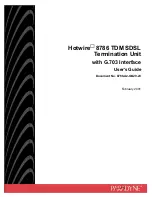
342-86400-498PS
Issue 1.2
April 2012
Page 76
Copyright
GE Multilin Inc. 2010-2012
Paddleboard Ports
Paddleboard
The first line indicates the type of the paddleboard used and its status.
The second and third line indicate the types of its plug-in sub-board
modules in banks A and B (if installed) and the summary status of
Ethernet ports for each of these modules. Note that the status of
individual Ethernet ports is reported in the Port Setup tab. Refer to that
field's description (later in this manual) for the list of possible readings.
Unit Monitor
Unit Status
Displays the current status of the unit. The possible readings are:
Xilinx did not boot
,
Bad voltage converter
(loss of 1.5 or 5 VDC),
Paddleboard
(paddleboard missing),
Temperature
(unit temperature
too high),
Clock Loss
(loss of clock on both Line ports),
VCXO125 Loss
(internal 125MHz VCXO failure)
VCXO38
(clock supplied from JMUX
unit is out of range), illegal D-PVLAN hairpinning, trunk VID conflict
with QVLAN ID, illegal port type mix on D-PVLAN, same QVLAN on
different D-PVLANs and
OK
.
Temperature
Displays the temperature inside the ETHER-1000 unit with a
2º C
accuracy. Normally the reading is about 15º C above ambient.
Network Monitor
For each provisioned TDM pipe, the following information is displayed:
Latency - Now/Peak
Indicates the curren
t and peak “around-the-ring” latency (in
milliseconds) for top priority traffic over the most recent period of time
whose duration is configured in the
Peaks for Last
field. The Left and
Right fields refer to the “right-to-left” and “left-to-right” paths
respectively.
Note
: In a linear network topology this field displays "-".
Hops Seen
Indicates the number of ETHER-1000 / ETHER-100 hops to the
farthest ETHER-1000 / ETHER-100 site visible from the given Line port
along the particular TDM pipe. In a ring-configured TDM pipe under
normal conditions, this number will be equal to the total number of















































